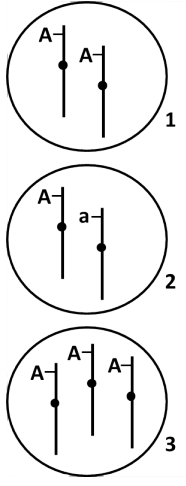Consider a hypothetical DIPLOID organism with ONE PAIR of homologous chromosomes. How many DNA molecules are there per nucleus in a somatic cell in G1? 4 8 2 1 Picture 1 shows Bob’s chromosome #18 pair. Picture 2 shows Sue’s chromosome #18 pair. Bob and Sue have a stillborn son with three copies of chromosome #18 that look like picture 3. In which parent did the chromosome separation problem occur? Bob Sue Both parents You need additional information to determine which parent. Starting with a population of genetically identical mice, you discover two new independent mutant strains in which all of the animals have epileptic seizures. In both strains, you know that the epileptic seizures are due to a single DNA mutation. You cross a mutant mouse from one strain to a mutant mouse from the second strain and find that none of their many offspring undergo spontaneous seizures. From this experiment you would conclude that the two mutant strains of mice most likely have mutations in… Two different genes on different chromosomes. Two different genes, but not necessarily on different chromosomes. The same DNA base position within a particular gene. The same gene, but not necessarily the same DNA base position.
Consider a hypothetical DIPLOID organism with ONE PAIR of homologous chromosomes. How many DNA molecules are there per nucleus in a somatic cell in G1?
|
4 |
||
|
8 |
||
|
2 |
||
|
1 |
Picture 1 shows Bob’s chromosome #18 pair. Picture 2 shows Sue’s chromosome #18 pair. Bob and Sue have a stillborn son with three copies of chromosome #18 that look like picture 3. In which parent did the chromosome separation problem occur?
|
Bob |
||
|
Sue |
||
|
Both parents |
||
|
You need additional information to determine which parent. |
Starting with a population of genetically identical mice, you discover two new independent mutant strains in which all of the animals have epileptic seizures. In both strains, you know that the epileptic seizures are due to a single DNA mutation. You cross a mutant mouse from one strain to a mutant mouse from the second strain and find that none of their many offspring undergo spontaneous seizures. From this experiment you would conclude that the two mutant strains of mice most likely have mutations in…
|
Two different genes on different chromosomes. |
||
|
Two different genes, but not necessarily on different chromosomes. |
||
|
The same DNA base position within a particular gene. |
||
|
The same gene, but not necessarily the same DNA base position. |

Step by step
Solved in 4 steps with 3 images




